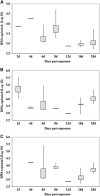Culex pipiens quinquefasciatus: a potential vector to transmit Zika virus
- PMID: 27599470
- PMCID: PMC5113053
- DOI: 10.1038/emi.2016.102
Culex pipiens quinquefasciatus: a potential vector to transmit Zika virus
Abstract
Zika virus (ZIKV) has become a threat to global health since the outbreak in Brazil in 2015. Although ZIKV is generally considered an Aedes-transmitted pathogen, new evidence has shown that parts of the virus closely resemble Culex-transmitted viruses. Therefore, it is important to evaluate the competence of Culex species for ZIKV to understand their potential as vectors. In this study, female Culex pipiens quinquefasciatus were orally exposed to ZIKV. Mosquito midguts, salivary glands and ovaries were tested for ZIKV to measure infection and dissemination at 2, 4, 6, 8, 12, 16 and 18 days post exposure (pe). In addition, saliva was collected from mosquitoes after infection and infant mice were bitten by infected mosquitoes to measure the transmission ability of Cx. p. quinquefasciatus. The results showed that the peak time of virus appearance in the salivary glands was day 8 pe, with 90% infection rate and an estimated virus titer of 3.92±0.49 lg RNA copies/mL. Eight of the nine infant mice had positive brains after being bitten by infected mosquitoes, which meant that Cx. p. quinquefasciatus could be infected with and transmit ZIKV following oral infection. These laboratory results clearly demonstrate the potential role of Cx. p. quinquefasciatus as a vector of ZIKV in China. Because there are quite different vector management strategies required to control Aedes (Stegomyia) species and Cx. p. quinquefasciatus, an integrated approach may be required should a Zika epidemic occur.
Figures


Similar articles
-
Culex mosquitoes are experimentally unable to transmit Zika virus.Euro Surveill. 2016 Sep 1;21(35):30333. doi: 10.2807/1560-7917.ES.2016.21.35.30333. Euro Surveill. 2016. PMID: 27605159 Free PMC article.
-
Zika virus replication in the mosquito Culex quinquefasciatus in Brazil.Emerg Microbes Infect. 2017 Aug 9;6(8):e69. doi: 10.1038/emi.2017.59. Emerg Microbes Infect. 2017. PMID: 28790458 Free PMC article.
-
Transmission Incompetence of Culex quinquefasciatus and Culex pipiens pipiens from North America for Zika Virus.Am J Trop Med Hyg. 2017 May;96(5):1235-1240. doi: 10.4269/ajtmh.16-0865. Am J Trop Med Hyg. 2017. PMID: 28500817 Free PMC article.
-
Zika virus: An updated review of competent or naturally infected mosquitoes.PLoS Negl Trop Dis. 2017 Nov 16;11(11):e0005933. doi: 10.1371/journal.pntd.0005933. eCollection 2017 Nov. PLoS Negl Trop Dis. 2017. PMID: 29145400 Free PMC article. Review.
-
Zika virus: a new pandemic threat.J Infect Dev Ctries. 2016 Mar 31;10(3):201-7. doi: 10.3855/jidc.8350. J Infect Dev Ctries. 2016. PMID: 27031450 Review.
Cited by
-
Vector competence of Aedes aegypti and Culex quinquefasciatus from the metropolitan area of Guadalajara, Jalisco, Mexico for Zika virus.Sci Rep. 2019 Nov 18;9(1):16955. doi: 10.1038/s41598-019-53117-1. Sci Rep. 2019. PMID: 31740702 Free PMC article.
-
Entomological Surveillance Associated with Human Zika Cases in Miri Sarawak, Malaysia.Am J Trop Med Hyg. 2020 May;102(5):964-970. doi: 10.4269/ajtmh.19-0339. Am J Trop Med Hyg. 2020. PMID: 32228777 Free PMC article.
-
Lessons learned on Zika virus vectors.PLoS Negl Trop Dis. 2017 Jun 15;11(6):e0005511. doi: 10.1371/journal.pntd.0005511. eCollection 2017 Jun. PLoS Negl Trop Dis. 2017. PMID: 28617808 Free PMC article. No abstract available.
-
Linking Only Aedes aegypti with Zika Virus Has World-Wide Public Health Implications.Front Microbiol. 2017 Jul 7;8:1248. doi: 10.3389/fmicb.2017.01248. eCollection 2017. Front Microbiol. 2017. PMID: 28736548 Free PMC article. No abstract available.
-
Global spatial assessment of Aedes aegypti and Culex quinquefasciatus: a scenario of Zika virus exposure.Epidemiol Infect. 2018 Nov 26;147:e52. doi: 10.1017/S0950268818003102. Epidemiol Infect. 2018. PMID: 30474578 Free PMC article.
References
-
- Dick GW, Kitchen SF, Haddow AJ. Zika virus. I. Isolations and serological specificity. Trans R Soc Trop Med Hyg 1952; 46: 509–520. - PubMed
-
- Dick GW. Zika virus. II. Pathogenicity and physical properties. Trans R Soc Trop Med Hyg 1952; 46: 521–534. - PubMed
-
- Macnamara FN. Zika virus: a report on three cases of human infection during an epidemic of jaundice in Nigeria. Trans R Soc Trop Med Hyg 1954; 48: 139–145. - PubMed
-
- Duffy MR, Chen TH, Hancock WT et al. Zika virus outbreak on Yap Island, Federated States of Micronesia. N Engl J Med 2009; 360: 2536–2543. - PubMed
MeSH terms
LinkOut - more resources
Full Text Sources
Other Literature Sources
Medical
